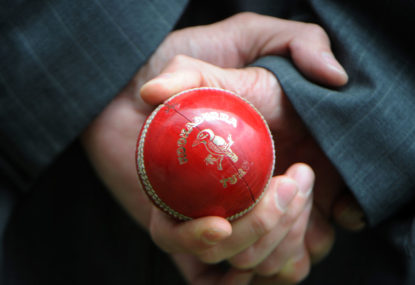Team of the Month: a May-born World Cricket XI
This series’ twelfth and final team has a distinct West Indian flavour at the top of the order, and a domineering captain.

Al Jazeera recently released a documentary on match-fixing in cricket, with one of the more shocking allegations made being the involvement of two players in the Australian Test side in spot-fixing.
The allegation, in short, is that in exchange for remuneration, batsmen scored slowly for a ‘session’ – a ten over segment.
The beginning of a session is apparently usually signaled by any manner of idiosyncratic mannerisms – removing the helmet, stopping a bowler before he bowls, calling for support staff onto the ground to name a few. Al Jazeera speculates that removing the helmet was the signal in this instance. It could, of course, very well be that the batsman in question was only removing his helmet due to the heat.
It is worth noting that while the so-called ‘fixer’ himself boasts that three members of the England team were on their payroll and names them voluntarily, while in the case of the Australian players, words seem to have been put in his mouth.
The journalist asks the fixer who was batting at the time of the ‘fix’, the fixer names the two batsmen and the journalist concludes that the two were on his payroll.
This seems a stretch – there is no direct outright acknowledgement from the fixer that one or both of the batsmen are involved. Contrarily, it seems unlikely that both batsmen were in on the fix and ended up batting together – how can anybody ensure that both batsmen will bat together for at least ten overs in order to undertake the fix?
Unless there is more evidence, which has not been aired, the conclusions drawn seem presumptive.
In addition, the fix conveyed seems vague, unlike the spot-fixing exposed by News of the World. The fixer conveys the odds being quoted by the bookies for the number of runs to be scored in the next ten-over session and tells the undercover agents to bet that fewer runs will be scored. He also says that the last over of the session is likely to be “manda“, which translates as a lean, low-scoring over.
Two runs or fewer were scored in around 44 per cent overs of the first innings and around 69 per cent overs of the second innings – does it really take a fix to predict that the last over of the session are going to be a low-scoring? This is hardly the same as saying that the second ball of the fourth over will be a no-ball.
[latest_videos_strip category=”cricket” name=”Cricket”]
Experts with far more authority have already weighed in on why the adverse risk-reward ratios for highly paid international cricketers make it unlikely that either Australian or English cricketers would have indulged in the behaviour alleged by Al Jazeera.
My contention is that Al Jazeera’s claims themselves do not appear to square up.
According to the documentary, at the time of the fix, the following conditions were satisfied:
1. The Australian team score was between 101 and 199 (The subtitles show the score as 1** to 1**).
2. The same two batsmen batted for the entire ten overs session.
3. The overs bowled were between 11 and 99 (The subtitles show the overs as ** to **).
4. The last over of the ten-over session was a maiden – the journalist cites this as validation of the fixer’s claim of a lean over.
5. The run-rate fell during this ten-over session – again, this claim is made by the journalist in the documentary.
If we analyse the Australian partnerships during the Ranchi Test, exactly three partnerships existed in both innings put together where the team score was between 101 and 199 – for the sake of brevity, let us call them partnerships one, two and three.
In the first partnership, there was one maiden over – however, this maiden occurred before the partnership could complete a ten-over session and there is no way this maiden over could be the last over of the session referred to by the fixer.
In the second partnership, there was one maiden over, however the runs scored in the ten-over period which ended with this over were actually more than the runs scored in the two preceding and one succeeding ten-over phases, and was at par with the innings run-rate. If the channel imagines that this was the partnership which was in on the fix, it appears as though the players never received the script.
In the third partnership, there were several maiden overs, however the likelihood of this partnership occurring itself was small and it seems that only a foolish fixer would try to spot-fix an event which depends on a partnership which might never occur. The odds seem too long – several other batsmen would have to fail in short order for this partnership to come about.
There are, therefore, really no set of events in the match that fulfill all the criteria laid down by Al Jazeera and demonstrate player intent to slow down the scoring rate. Mere accusations by an unsavory criminal cannot be the sole basis for accusing anybody.
The channel’s entire case apparently hinges on the fixer’s successful prediction of a low-scoring over, but it needs to be asked if the successful prediction of a low-scoring over in a match where 54 per cent of the overs were low-scoring constitutes evidence of a fix.
While a more detailed investigation might prove me wrong, at this stage, the allegations against the Australian players seem to be sensational claims, backed by weak, circumstantial evidence which would, by itself, be unlikely to withstand legal scrutiny.
Unless Al Jazeera has further incriminating evidence, which it has not aired, it’s unfair to the Australian team that the channel aired these allegations.